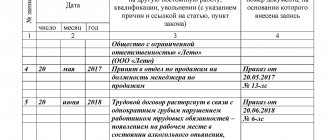Drunkenness in the workplace is absolutely unacceptable, regardless of what position a person holds and what his range of responsibilities is. A drunk employee poses a danger not only to himself, but also to his colleagues, as well as to the production process.
The ban on drinking alcohol at work is enshrined in labor legislation. Based on this, an employer who suspects one of the employees of drinking alcohol can initiate an inspection, and if the results of the investigation confirm the fact of drunkenness, the case may end in dismissal.
Showing up at work while intoxicated
An employee who is intoxicated at the workplace not only cannot work fully, but also interferes with the functioning of the entire enterprise or office and distracts colleagues. In addition, a drunk person, intentionally or unintentionally, can create situations that threaten the health and sometimes the lives of himself and other employees.
Naturally, such situations are unacceptable for management, so in most cases a decision is made to dismiss.
Dismissal
You can determine that a person is drunk by external signs and his behavior. Some enterprises conduct a mandatory medical examination of employees at the beginning of the working day, during which alcohol intoxication can be detected using a breathalyzer.
How to prove that an employee is drunk and record it?
The following signs will help you understand that a person is drunk at work:
- smell of alcohol on the breath;
- incoherent speech;
- unsteady gait, poor coordination of movements;
- dilated pupils;
- flushed face;
- inappropriate, inappropriate behavior.
If you notice one or more of the listed symptoms, you must act by strictly following the sequence of steps and carefully filling out all the necessary documents. The first step will be the creation of a special commission.
Creation of a special commission
By order or directive, the head approves the composition of the commission that will investigate the incident and its powers. For greater objectivity, the commission must have at least three people. Members of the commission draw up all the necessary documents confirming the fact that the employee is intoxicated at work.
Video recording of what is happening
A video recording of a drunk employee at work will serve as additional evidence in the event of a trial.
If it happens that the documents were executed improperly or violations were committed during the medical examination, the dismissed employee may file a lawsuit demanding that the dismissal be declared illegal. In such a situation, the employer will be able to prove his case by providing video materials in court. They will also come in handy when the court considers the testimony of witnesses insufficient.
Explanatory notes
An employee who shows up to work drunk must write an explanatory note, detailing what caused the situation. If a person is not able to draw up a document immediately, he can do it the next day. It is impossible to force an employee to provide an explanation. But if within two working days after the incident the document is not presented, it is necessary to draw up an act of refusal to give explanations.
Drinking at work
Also, explanatory notes are provided by the immediate supervisor of the drunk employee and witnesses from among the personnel of the production workshop or office.
Act on violation of labor discipline
Members of the commission must prepare a document documenting the fact of the violation. It can be called differently: act, memorandum, memo, and be drawn up in any form. The main thing is that it reflects the basic data, namely:
- Full name and position of the employee who was intoxicated;
- Full name and position of the person who discovered the violator;
- all noticeable signs of intoxication;
- Full name of witnesses;
- information about the employee's suspension from work.
The act must be signed by all persons specified in it. If the violator refuses to put his signature on the act, this fact also needs to be recorded.
Drawing up an order to remove an employee
An order to suspend an employee for being drunk at work is drawn up in any form, since there is no unified form for this document. It is necessary to scrupulously and accurately indicate all relevant circumstances and details, make footnotes to all available documents (acts, explanatory and memos).
In addition, the order specifies the period of suspension and records the fact that wages have not been accrued for this period.
Medical examination procedure
To confirm that an employee appears to be intoxicated, the employer must invite the offender to undergo a medical examination. This needs to be done as quickly as possible, before the alcohol leaves the body.
If he agrees, the employee is given a referral to a medical institution that is licensed to provide such services and has qualified specialists and the necessary equipment.
Survey
In order to conduct an examination, exhaled air, urine, and in some cases blood are tested for alcohol. Based on the results, the doctor draws up a report in which he indicates the test results and gives his conclusion.
Refusal of medical examination
The employer is obliged to offer the employee to undergo a medical examination for the presence of alcohol in the blood, but has no right to insist or force him to undergo this test. The employee, in turn, has the right to refuse the offer. In this case, a certificate of refusal is drawn up, which is attached to the remaining documents.
Who pays for the medical examination costs?
Payment for the services of the medical institution and the examination procedure is made by the employer. To do this, the company must have a concluded agreement with honey. institution, as well as collect all documents for payment and checks. This is necessary so that later it will be possible to recover the amount spent from the violating employee.
Registration of suspension from work
In order to prevent an employee from working, you must have documentary evidence of the occurrence of one of the above circumstances. If there are not enough documents for confirmation, then management cannot prohibit the worker from performing his job functions.
There is no single form of document capable of confirming the lack of the right to continue working. As a rule, you need to prepare the following documents:
- An act is a document drawn up by members of the commission and recording the fact of the occurrence of a circumstance in which it is not possible to continue work under the Labor Code of the Russian Federation or Federal Law. The act is certified by the compiler and witnesses, and therefore is a legal confirmation of the occurrence of the event specified in it;
- A memo is a document drawn up by the violator’s immediate superior and intended to inform management of the occurrence of an event established in the report. That is, the act is an annex to the note;
- Other papers that can confirm the required event, depending on the basis for removal, the list of documentation may be supplemented.
Is it possible to fire without a medical examination?
The court, when considering cases of dismissal for drunkenness in the workplace, takes into account not only the results of a medical examination, but also other collected documents confirming the fact of the violation.
It must be taken into account that in the absence of a medical certificate, it will be more difficult to prove the fact of being drunk at work, and the court may take the side of the dismissed employee. However, it cannot be said that in the absence of a doctor’s conclusion, it will be impossible to dismiss an employee. Each situation is considered by the court on an individual basis.
Responsibility of the employer for not suspending an employee while intoxicated
If the employer knows that a drunk employee is in the workplace and does not take any measures, in particular, does not suspend him, then responsibility for possible consequences automatically passes to the employer.
Such cases are regulated by the Code of Administrative Offenses, and if, due to the employer’s inaction, an accident or other incident occurs due to the fault of a drunken employee, including one that resulted in injury or death, the case is reclassified as criminal.
The Administrative Code implies the following punishment:
- for officials – from 1 to 5 thousand rubles;
- for individual entrepreneurs – from 1 to 5 thousand rubles;
- for legal entities – from 30 to 50 thousand rubles.
Responsibility under the Criminal Code of the Russian Federation is much more serious and implies not only large fines, but also imprisonment.
Responsibility
In order to avoid dangerous accidents at work and unpleasant consequences, employers are obliged to ensure that there are no alcoholics in the team and to very quickly get rid of those who appear drunk at work.
Suspension from work when license is suspended
If a license or right to work is suspended for a period of up to 2 months, the employee is suspended from work for this period. An example of this would be an employee in the position of a driver who has been deprived of his license.
If it is possible to temporarily transfer an employee to another location, then this should be done. If this is not possible, then the employee’s work activities are temporarily suspended. An offer for another job must be made in writing against signature.
If the license or right is lost for a longer period, management will be able to terminate the employment relationship by terminating the relevant contract.
Permission to work after suspension
After the period for which the employee was suspended from work for appearing at the workplace while intoxicated has passed, the employer will have to decide on the possibility of his return to work. In most cases, management takes a strict view of such offenses and, in order to avoid recurrence, decides to fire the offender.
But in some cases, the employer meets the employee halfway and decides to allow him to work. This must also be documented using an admission order. The employee must be familiar with the order, a copy of which is sent to the accounting department.
Most often, the offense does not go without punishment, the choice of which remains with the employer. Usually for the first time they limit themselves to a reprimand. Sometimes the employee is required to pay a fine.
Definition of the concept
The concept of “appearing at work while intoxicated” includes:
- employee arriving drunk;
- drinking alcoholic beverages on the territory of the enterprise/production.
A report on an employee being in a state of intoxication can be drawn up if the employee is at other facilities where the employee is sent by the management of the organization.
Important! Dismissal is threatened for a one-time violation of labor standards, if the fact is recorded in accordance with all the rules: a report on the condition is drawn up, alcohol intoxication is confirmed, an order to remove labor duties is signed. The date of the act is entered online - it is unacceptable to draw up a document in the past (backdated) date.
Dismissal procedure
If the employer has decided to fire an employee for being drunk at work, then he can go to a meeting and invite the offender to write a statement of his own free will. In this case, everything goes peacefully by mutual agreement of the parties.
However, quite often the manager, wanting to punish the offending employee, formalizes dismissal under the article for drunkenness. The step-by-step action plan is as follows:
- Prepare a dismissal order.
- Familiarize the employee with the order (he must sign, confirming the fact of familiarization with the order). If an employee refuses to sign a document, a statement of refusal is drawn up, which is certified by the signatures of three employees. In this case, a refusal note is added to the order.
- Make an entry in the work book indicating the relevant article of the Labor Code of the Russian Federation. Give the employee a work book.
- Instruct the accounting department to make a full calculation.
In this case, it is very important to do everything correctly so as not to soon have to meet the former employee in court, where he may come to challenge the dismissal.
Employee intoxication report
To create an act, a special commission is assembled, which assesses the employee’s condition and establishes criteria by which the presence of one of the types of intoxication can be accurately confirmed. The act can be drawn up without the participation of doctors if the members of the special commission can clearly determine the worker’s drunken state based on the existing signs.
To create a commission for drawing up an act, an order is formed, which indicates information about the composition of the commission and a list of tasks that are assigned to them. The contents of the order are conveyed to each member of the commission against signature.
If an act is not drawn up within the next few hours from the moment the employee’s drunken state is discovered, then it will be much more difficult to prove the fact of intoxication.
The act must include the following information, presented in free form:
- Date the violation was recorded;
- Exact time of detection of employee intoxication;
- Place of execution of the act;
- Information about the offender;
- Signs of intoxication detected by the commission members (smell, slurred speech, swaying gait, change in complexion);
- The conclusion of the commission on the presence of intoxication in the designated person;
- Information about the persons drawing up the act.
It is important not to confuse the state of intoxication with manifestations of the disease, since all the above signs are also characteristic of a painful state. If in doubt, it is better to seek the help of medical professionals.
The act is handed over to the intoxicated worker for review and signature. It is also recommended to immediately invite the employee to write an explanatory note, the content of which will confirm the violation of the employee’s thought process, incoherence and inconsistency of speech.
If a decision is made to remove an employee from work, an order is drawn up. The order must contain;
- Information about the employee for whom the violation was recorded;
- Order to suspend from work;
- Circumstances for removal;
- List of supporting documents;
- The period of suspension is determined by the medical examination protocol; if one has not been drawn up, it is determined by the supervisor, based on the person’s condition, the degree and cause of his intoxication.
The order is approved by the signature of the manager and handed over to the suspended employee for review against signature. For this violation, the employer has the right not only to not allow the employee to work until he sobers up, but also to fire him under Article 81. Labor Code of the Russian Federation.
Is it possible to challenge dismissal and return to work?
If an employee who was fired for being drunk at work does not agree with the fact of dismissal, he can file a claim with the court or the labor inspectorate. At the same time, he must be ready to prove his innocence and the illegality of his dismissal.
The trial is underway...
The following may be presented as evidence:
- witness statements, surveillance camera footage confirming that the employee was sober;
- testimony of the attending physician, prescription for medicine, medical report (if the apparent intoxication was caused by taking alcohol-containing drugs or a health condition);
- analysis of documents submitted by the employer, indicating inaccuracies or violations in design or substance.
The most effective way to prove the employer wrong is to agree to undergo a medical examination and obtain a conclusion that there is no alcohol in the blood.
Having sufficient evidence, an employee can not only convince the court that he is right, but also present his demands to the employer, for example:
- about returning to work with retention of position and salary;
- on full payment for the entire period of proceedings during which the employee did not receive wages;
- on compensation for moral damage.
If there is evidence presented, the court quite often satisfies the employee’s demands in full.
Grounds for suspension from work
A worker is not allowed to work if he:
- Is under the influence of narcotic, alcoholic or toxic substances.
- Not prepared for safe work due to lack of proper information and failure to pass a control test of knowledge on labor protection.
- Failed to pass a medical examination or psychiatric examination when this is required by labor law.
- For medical reasons, unsuitable for the job performed.
- Carries out labor activities in accordance with a license, the validity of which is suspended for a period not exceeding 2 months.
- Not allowed to enter the workplace by decision of the relevant authorities that have the ability to approve such decisions.
- Suspected of a criminal offense, and at the same time his work involves interaction with minors.
- Falls under the scope of the Federal Law and other acts establishing cases of work restrictions.
If the events listed above occur, the employee is not allowed to enter the place of work until the circumstances on the basis of which the suspension occurred are eliminated. In some cases, eliminating the circumstance alone is not enough to return to work; sometimes additional actions specified in the Federal Law and other regulatory documentation are required.





